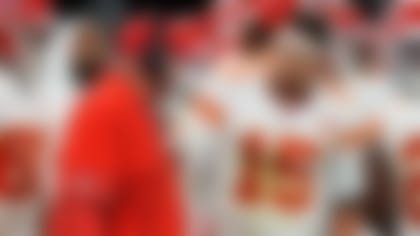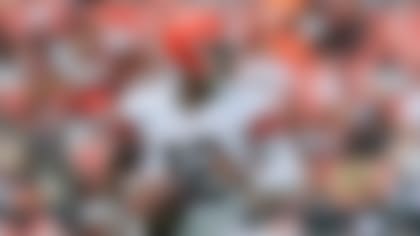Team builders are always looking to other sports for new and innovative ways to build championship squads. General managers and executives will pick the brains of their baseball, basketball and hockey brethren to see if there are emerging trends that would translate to the NFL.
The Los Angeles Lakers dominated headlines by pulling off a blockbuster trade to acquire six-time All-Star forward Anthony Davis from the New Orleans Pelicans for three players and three additional first-round draft picks. This lines up with my belief that we are seeing more team builders opt for established stars over draft picks in multiple sports. Although the allure of taking a chance on what's behind Door No. 1 in the draft is intoxicating for some general managers, there is also security in acquiring a player with a proven track record of producing at the highest level.
Davis is a top-five player who averaged 25.9 points, 12.0 rebounds and 3.9 assists per game last season, thanks to his MVP-caliber game. Pairing the ultimate big man with a three-time NBA champion regarded by some as the "G.O.A.T." (LeBron James) definitely makes the Lakers viable title contenders in a star-driven league. Now, I know it is a little easier to use the star model in a five-man sport, but NFL teams have started to utilize the approach, particularly those with a young quarterback playing on a rookie deal.
Over the past two years, we've seen several teams with young QB1s auction off first-round picks for some star power. Last year, the Los Angeles Rams added receiver Brandin Cooks to the lineup to give Jared Goff an explosive pass catcher to target on the perimeter. The Chicago Bears scooped up Khalil Mack last September to give the defense a "closer" to finish off lopsided games, sparked by a Mitchell Trubisky-led offense. Jerry Jones made a major move for the Dallas Cowboys in October to give Dak Prescott a legitimate WR1 in Amari Cooper.
Not to be outdone, the Kansas City Chiefs traded away a first-round pick this offseason to add a dominant pass rusher in Frank Clark to the mix. With Patrick Mahomes lighting up scoreboards around the league, the Chiefs need a sack master to finish off games. In Cleveland, the Browns added Odell Beckham Jr. to an offense that was already brimming with explosive playmakers on the perimeter. The electric pass catcher will give Baker Mayfield a WR1 with the sauce to change the culture in the Dawg Pound.
Those are just some of the moves that have been made in the NFL recently. Considering how executives are more willing to explore the trade market with young quarterbacks playing on cheap rookie deals while their teams are in "win now" mode, I believe we could see a few teams embark on some additional wheeling and dealing to add some star power to their lineups via a major trade.
Inspired by the Davis trade, I surveyed the NFL landscape to see which teams are a player or two away from making some noise as a potential playoff or title contender. Here are five teams that I would love to see make a blockbuster trade heading into the season, listed along with their potential ideal trade targets:
BALTIMORE RAVENS: Whitney Mercilus, LB or Jadeveon Clowney, LB, Texans. The surprising departure in free agency of seven-time Pro Bowler Terrell Suggs left a huge void in the Ravens' lineup at pass rusher. The menacing veteran's game has started to slip heading into Year 17, but he remains a scary threat for opposing quarterbacks off the edge. No. 55 has wreaked havoc on the perimeter for Baltimore since 2003; now, the Ravens need to find a new bully on the block after also losing Za'Darius Smith as a free agent. The defense helped ensure a successful transition to the job of QB1 as a rookie, holding Baltimore's opponents to an average of 18 points and 277 yards per game while Jackson went 6-1 to close out the regular season. The team is counting on third-round pick Jaylon Ferguson to step into a major role, but the Ravens could still use a pass rusher with star power, like Mercilus or Clowney, both of whom are entering contract years in Houston (barring an extension for the franchise-tagged Clowney), to extend the dominance of a defense that ranked first overall and fifth against the pass in 2018.
HOUSTON TEXANS: Melvin Gordon, RB, Chargers. The Texans made a concerted effort to upgrade the protection around quarterback Deshaun Watson, who was sacked a league-high 62 times last season, during the draft. Establishing a more consistent running game might also help temper their opponents' aggression. Sure, Lamar Miller has shown flashes as the team's RB1, but the veteran hasn't cracked the 1,000-yard mark in either of the past two seasons, and his relatively paltry total of 100-yard games during that span (four) certainly doesn't keep opposing defensive coordinators up at night. Gordon, who is entering the final year of his rookie contract, has been negotiating with the Chargers, but if talks break down, maybe the Texans should knock on L.A.'s door in an attempt to upgrade a running game that needs some more juice.
NEW YORK JETS: Jimmy Graham, TE, Packers. The Jets' ascension to the top of the AFC East will be fueled by Sam Darnold and his growth as a QB1 in Year 2 of his NFL career. The team added the ultimate weapon to the backfield in Le'Veon Bell to give the young quarterback an electric RB1/WR2 to lean on in critical situations. And free-agent signee Jamison Crowder will further help bolster a pass-catching lineup that features intriguing talents Robby Anderson and Quincy Enunwa at receiver and Chris Herndon at tight end. Even so, the Jets could use another playmaker with the capacity to do damage over the middle of the field. Graham would be an interesting option as a veteran pass catcher with mismatch potential as a "flex" tight end. He was a bit of a disappointment in Green Bay during his first season with the Packers (55 catches, 636 yards, two touchdowns), so the former All-Pro could be a viable option if he doesn't quickly acclimate to new coach Matt LaFleur's system in training camp.
BUFFALO BILLS: Jordan Reed, TE, Redskins. The Josh Allen era got off to a good start a season ago, as the young quarterback dazzled the league with his athleticism and running ability. Heading into Year 2 of Allen's career, the Bills have attempted to surround him with more playmakers in the passing game to enable him to show off his arm talent as a deep-ball thrower. Buffalo signed Cole Beasley and John Brown to stretch the field horizontally and vertically, but the team still needs a "chain mover" and red-zone weapon to act as Allen's security blanket in critical moments. Reed would thrive in that role as a dynamic "flex" tight end with outstanding quickness, agility and route-running skills. With third-round pick Dawson Knox and seventh-round pick Tommy Sweeney serving as young apprentices for the Bills, the addition of an established playmaker at tight end could help accelerate Allen's growth as a franchise quarterback.
WASHINGTON REDSKINS: Mohamed Sanu, WR, Falcons. The 'Skins haven't had a legitimate WR1 since DeSean Jackson and Pierre Garcon shared duties a few seasons ago. Whether rookie Dwayne Haskins or veteran Case Keenum is under center, the team desperately needs a credible threat on the perimeter to complement a rugged running game spearheaded by running backs Adrian Peterson and Derrius Guice. Imagine a big-bodied, hard-nosed pass catcher like the 6-foot-2, 215-pound Sanu coming onboard to give the 'Skins a dependable chain mover to anchor the passing game. Sanu is coming off his most productive NFL season yet, yardage-wise (838), but with Calvin Ridley securing 10 touchdown catches as a rookie (plus 821 receiving yards) alongside Julio Jones, might Atlanta be tempted to move Sanu for additional draft capital?
MICHAEL THOMAS: Is he a $20 million playmaker?
As the NFL continues to trend toward a passing league, the value of WR1s with strong hands, A-plus size and clutch playmaking ability could finally lead to a receiver topping the $20 million mark in average annual value (AAV), with marquee pass catchers viewed as essential pieces of the offensive puzzle. And the New Orleans Saints' Michael Thomas, who is entering the final year of his rookie deal, could be the one to set the bar for No. 1 receivers.
Now, I know that might surprise some observers who see Julio Jones ($14.25 million AAV), DeAndre Hopkins ($16.2 million), Antonio Brown ($16.71 million) and Odell Beckham Jr. ($18 million, currently the leader among receivers) as the standard bearers at the position, but Thomas deserves to be in the conversation as the NFL's WR1 based on his numbers alone.
The fourth-year pro has at least 90 catches and 1,000 yards in each of his first three seasons in the league, including a 125-catch, 1,405-yard campaign in 2018. Thomas dominates opponents as a big-bodied slot receiver, exhibiting a rugged playing style that overwhelms defenders between the hashes. Additionally, No. 13 flashes a crafty route running style that makes him hard to guard in one-on-one matchups against cornerbacks and safeties in the slot or out wide.
Some observers have suggested Thomas' success is a byproduct of playing with a potential Hall of Fame quarterback (Drew Brees) in a system choreographed by one of the best play-callers in the business (Sean Payton). But I believe he is a blue-chip player with a game that's perfectly suited for any system. He can thrive as a bully on the outside as a classic "X" (split end) or move around the formation as a versatile weapon between the hashes.
"He's a really good player," said an NFC personnel executive. "He's a tough evaluation, because he's a little awkward and herky-jerky ... He double-catches balls, but he's strong and doesn't drop anything.
"I think his style messes up cornerbacks because it's unique and unorthodox, but it works for him ... I like his game."
To that point, there's been plenty of conversation in league circles suggesting Thomas is plugged into the role once played in the Saints' offense by Marques Colston, who averaged 74 catches, 1,027 yards and eight touchdowns per season from 2006 to 2014 (Colston's last season, a 45-catch, 520-yard, four-score effort in 2015, was less memorable). As a big-bodied pass catcher with big hands and a rugged demeanor, Thomas excels as a quasi-tight end working down the seams. Like Colston, Thomas is a mismatch deployed like a key chess piece by Payton.
With that in mind, it makes perfect sense for the Saints to pay top dollar for the headliner of their offense. Thomas is the engine that makes the passing game go, and his presence opens up the field for others. Sure, he shares the marquee with running back Alvin Kamara, but Thomas is unquestionably Brees' top target, and the team should compensate him at a rate commensurate with his value to the team. In fact, outside of Cam Jordan and Brees, you could make the argument that No. 13 is the team's MOP (Most Outstanding Player), which makes him a franchise player. Based on how other teams are paying their franchise players, including Khalil Mack ($23.5 million per year from the Bears) Aaron Donald ($22.5 million from the Rams), DeMarcus Lawrence ($21 million from the Cowboys) and others, Thomas has a strong case to crack the $20 million mark.
Remember, the only positions checking in among the top 25 annual earners are quarterbacks, pass rushers and pass catchers. Over the past three seasons, Thomas ranks first in the NFL in combined receptions (321), fifth in combined passing yards (3,787) and tied for sixth in receiving touchdowns (23). He also has the best catch percentage (77.0%) of any player with 200-plus receptions in that span; the next closest wide receiver is Adam Thielen with 70.5%. Thomas deserves to be in the "quarterback money" territory, based on his standing as a top-five player at a premier position.
"We've had some conversations, and I like keeping that close to the vest until there's something to report, but look, we love what Mike's done for us," Saints' general manager Mickey Loomis recently told Adam Schein on Sirius XM Radio. "He's a fantastic player, one of the best at his position in the league, and hopefully we can keep him a Saint for a long time as well."
With both sides intent on getting a deal done prior to training camp, it's only a matter of time before Thomas raises the bar for franchise receivers.
TWO-POINT CONVERSION: Quick takes on developments across the NFL
1) Jets headed for defensive revival under Gregg Williams. I've never played for Gregg Williams, but I love the energy and passion that he brings as a coach. As a former defensive player, I've always perked up when listening to him speak at the podium, and his ultra-aggressive defense appears to be something that I would have enjoyed as a player.
That said, his attitude and approach to unit-building fascinate me far more than his exotic schemes and complex tactics.
"The reason I keep getting hired is culture," said Williams, who is now working for his eighth different franchise, during a press conference earlier this month. "Culture beats strategy any day of the week. It's about how you find ways yourself to be tougher, how you find ways to play harder, play smarter for longer than any opponent you go against. All the scheme is, is a way to surround the ball, surround the formation. Then it's find ball, see ball, get ball. But it comes from an attitude. It comes from a personal understanding of what it takes to play this game at this level at the highest level."
I love hearing a coach tout culture over the scheme in a meeting room. The great defensive coaches who I've played for repeatedly stressed the importance of playing hard and together at every turn. From Fritz Shurmur to Dick Jauron to Gunther Cunningham to Willie Shaw, the top defensive coaches stress the importance of playing as one and running to the ball with fanatical effort. Additionally, they emphasized the importance of getting the ball (generating takeaways), making that the focal point of their defensive approach.
Although schematics varied from coach to coach, I believe the feeling and attitude conveyed by each coach outweighed any of the X's and O's drawn up on the board. In fact, they would frequently tell the defense that pro football in the NFL is a player's game, and the job of the coaches is to simply put the best players in the right places to provide them with enough opportunities to make plays.
What does that mean for the Jets?
I believe Williams is going to build the defense in his image as a hard-nosed, scrappy unit that comes after opponents with relentless pressure. He is a high-risk, high-reward play-caller who believes in bringing pressure from all angles from a variety of looks. Whether it's a 4-3 or 3-4 front on early downs or some form of an exotic, sub-package pressure from a 3-3 or 2-4 front with nickel personnel behind it, Williams will put together an assortment of "A.F.C." (automatic front and coverage) looks that are designed to blitz the formation and nullify the top three or four run and pass plays from that designated formation.
While that approach seems complex and complicated on the surface, it is one of the ways a defensive coordinator can maximize the talent on the squad, by putting guys in optimal positions to get to the ball.
"I have 42 packages of defense," Williams said. "What does that mean? Forty-two ways to get these 11 guys out there. I'm not going to do all of those here. Right now, we only have 14 or 15 of them, how to package guys to get out there, who's going out there. After going through the OTAs and the minicamp, I have a better feel for these guys. I thought I knew them, now I think I have a good feel for them, and you really don't have it until you get into the big-time games. Not the preseason; it takes a few seasonal games to see how you respond under pressure.
"We're going to package as many as we can to get guys ready to go. People talk about starters. Everybody who makes the team is a starter in the National Football League."
Studying the Jets' defensive depth chart, I see plenty of intriguing chess pieces for Williams to play around with to create headaches for offensive coordinators. Like most championship-caliber defenses, the Jets have playmakers down the middle, with Leonard Williams, Quinnen Williams, C.J. Mosley and Jamal Adams positioned in key spots. The quartet's individual and collective ability should discourage opponents from attacking between the hashes and force them to play the game on the edges.
If the Jets have assembled enough athletic playmakers at perimeter spots (defensive end/outside linebacker and cornerback), the collective speed of the unit will run down the ball before it gets to the corner and hold opponents to minimal gains. Moreover, the combination of the hats flying to the runner and an "attack the ball" mindset should produce turnovers, which is the biggest deciding factor in winning games.
Remember, when Williams directed a ball-hawking defense in New Orleans that sparked the team's charge to a Lombardi Trophy in 2009, the unit produced the second-most takeaways in the NFL due to an ultra-aggressive approach. Williams was ultimately punished and suspended for some of the tactics he employed while with the Saints, but since his reinstatement, he's made the most of his opportunities, which included working as the Browns' interim head coach to close out last season. The grizzled defensive architect could lead a defensive revival in New York fueled more by an attitude change than a schematic adjustment.
2) Redskins finding right role for ex-Giant Flowers. In the NFL, one man's trash can quickly become another man's treasure. That's why I'm not surprised at the reports suggesting Ereck Flowerswill start at left guard for the Washington Redskins. Despite the ninth overall pick in the 2015 NFL Draft failing mightily as an offensive tackle for the New York Giants, the 6-foot-6, 334-pounder is viewed as a potential key contributor as an interior blocker for Washington.
"I see a lot of potential when we've moved tackles inside," Redskins' assistant head coach and offensive line coach Bill Callahan said, via The Washington Post, noting former backup lineman Ty Nsekhe's occasional moves to guard as an example.
"I think it gives us size, it gives us power, I think those are really good traits for the running attack and pass protection," Callahan continued. "He's long, he's square, obviously he can play in the short area, so those are things we kind of identified during free agency that we liked, and we are trying to fit him into that mode. So it's been a work in progress, we got a long ways to go yet, but he's made a nice transition."
The glowing scouting report from one of the best offensive line coaches in football seems to run counter to the reports on Flowers' ability from his time in New York, but NFL coaches are always willing to take on a reclamation project if the player is talented and has some core traits needed to succeed. Flowers was universally viewed as a first-round talent in the 2015 draft due to his combination of size, strength and athleticism. He was ideally suited to play right tackle because of his mauler/brawler blocking style and overall explosiveness. Not to mention, Flowers had experience playing left and right tackle after logging 28 starts as a collegian at Miami.
In New York, Flowers struggled as a frontline starter at left and right tackle before being released in October. His difficulties could partly be attributed to his shoddy footwork and fundamentals in pass protection. Pass rushers would blow past Flowers on a variety of finesse moves that exposed his lack of balance and body control in space. The veteran blocker would resort to clutching and grabbing defenders to keep them away from the quarterback, but the penalties and constant pressure eroded any confidence the coaching staff had in the former first-round pick.
Although the Giants attempted to move Flowers to right tackle prior to his final season to resuscitate his career, he was replaced by Chad Wheeler in Week 3 and was eventually released a few weeks later. The Jaguars picked up Flowers and inserted him into the starting lineup for final seven games of the season at left tackle but decided to go in a different direction in the offseason.
Considering Flowers' failure in his previous stops, the Redskins' strong endorsement of the mammoth blocker certainly will draw some eye rolls in the scouting community, but I learned from the late Al Davis and Hall of Fame executive Ron Wolf that teams should always take a peek at a former first-round pick if he's available on the street. The wily personnel men believed players picked in the first round possessed A-level talent, and that a change of scenery or coaching might be able to unlock their potential.
Wolf, in particular, told me that finding the right role or scheme could make a world of difference for a player, and it's worth the risk to bring a so-called bust into camp to see if the coaches can identify the issue.
In Washington, Callahan sees a hidden gem in Flowers as a big-bodied road grader with the combination of strength and power to move defenders off the ball. The move to left guard puts Flowers in tight quarters, which will help him as a pass blocker. Instead of defending edges with unlimited space as a right or left tackle, he will get a chance to deal with pass rushers in a phone booth, with the center and tackle in close proximity.
In the running game, the move to left guard will enable Flowers to become a downhill player in the Redskins' gap scheme. He will get a chance to combo block on nose tackles on power runs to his side, or wrap around the center and guard to latch onto linebackers on power runs to the opposite side.
For a team looking to cram the ball down the throats of its opponents, with Adrian Peterson and Derrius Guice running the rock, the 'Skins might've found an unlikely difference maker on the scrap heap this offseason.
Follow Bucky Brooks on Twitter @BuckyBrooks.












